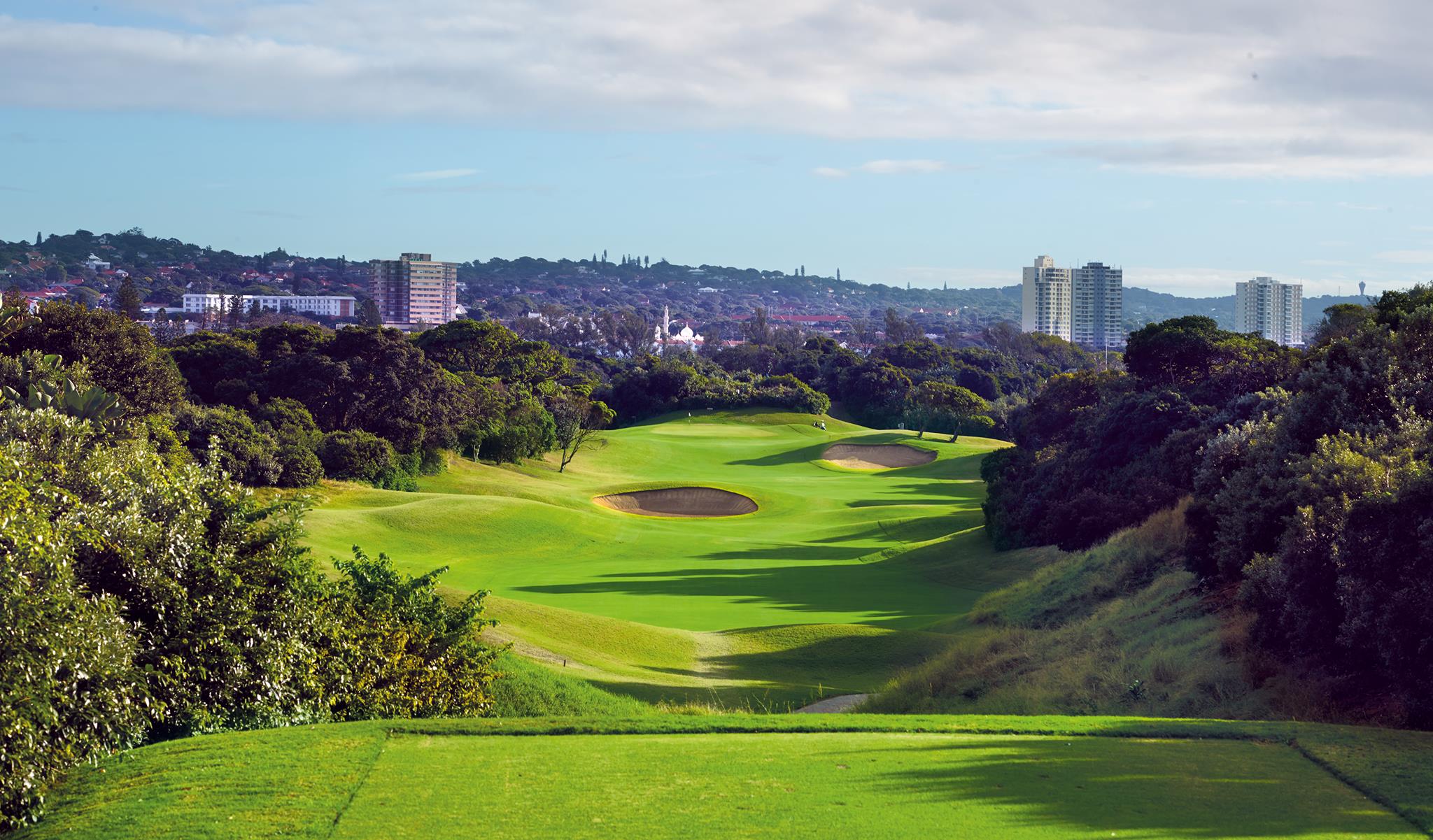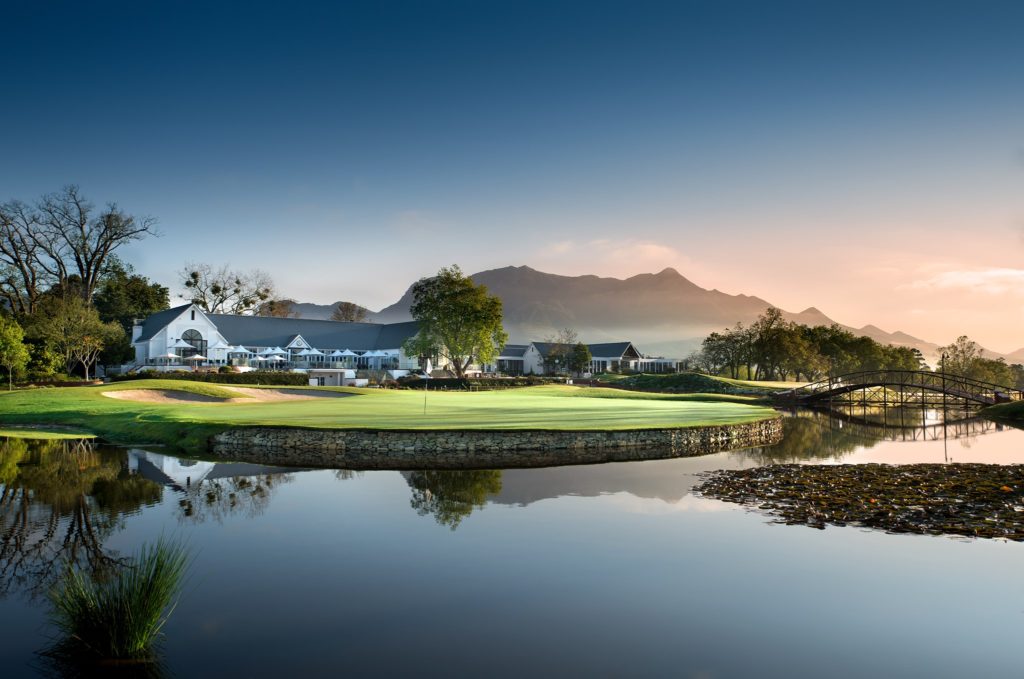
Durban Country Club
If you’re like most Americans, the first thing that comes to mind when someone mentions South Africa likely has to do with Nelson Mandela, a wildlife safari, the 2010 World Cup where the fans tooted vuvuzelas during the soccer matches, or something you’ve seen in the movies.
If you’re a golfer, the names Player, Els, Oosthuizen, Schwartzel and Grace also have a place in your mindset.
But have you ever really given much thought of traveling to South Africa, which is clear on the other side of the world and deep into the Southern Hemisphere? Well, you should — even more so if you are a golfer and looking to play a variety of courses in differing climates and styles, from the prairielands to the beach to the mountains and even through vineyards.
A South Africa golf trip is wild, wooly, adventurous and sublime, and one that you’ll never forget. The Travel Caddie spent 11 days there, playing 10 golf courses in settings of lush jungle, natural dunes alongside the Indian Ocean, along the tranquil Bot River Lagoon, in the wine country of the Berg River Valley, on one of the world’s top 40 courses, and in the shadow of Table Mountain.
There’s really no way to explain how great this trip really was, but I shall try.
This feature will outline five of those courses — San Lameer Estate GC in Margate, Zimbali Coastal Resort in Dolphin Coast, Durban Country Club in Durban, and the Links and Montagu courses at the Fancourt Resort in George, considered by many to be the “Pebble Beach of South Africa.”

Fancourt
Getting to South Africa is part of the fun
South Africa is obviously a long way away from anywhere in the United States. But there are non-stop flights available from as close as many of the United States major airport hubs into Johannesburg.
An upgrade to business class (with its totally reclining sleeper seats, three sumptuous meals and free liquor and myriad personal entertainment options) make the 18-hour, one-way flight (I know, gulp) actually enjoyable, especially when you realize what’s waiting for you when you land.
Our group began all over the United States (San Jose, Minneapolis, Austin, Chicago and Vermont) and met in either New York City (Kennedy Airport) or Washington D.C. (Dulles) to catch our South African Airways flights. The service aboard was impeccable, and the flight attendants were friendly and all spoke perfect English, as well as the other 10 official languages of South Africa.
Because it is the sole nonstop gateway from North America, most U.S. visitors arrive via Johannesburg, giving them a huge savings over changing over in Europe or the Emirates.
My flight stopped in Accra, Ghana for an hour to drop off and take on passengers and to refuel, but I never even got off the plane.
Once in Johannesburg, I checked into the Southern Sun Hotel on the grounds of O.R. Tambo International Airport and got a good night’s sleep. In the morning I had a sumptuous and expansive breakfast buffet in the open-air dining room that was filled with business travelers and tourists from all over the globe.

Zimbali Coastal Resort
Playing golf on South Africa’s southeastern coast
After breakfast, I headed back into the airport to meet with the group and board a small airplane for the hour and a half flight to Margate, a beach community on the coast of the Indian Ocean. From there we travelled south about 10 miles to the San Lameer Estate (golf resorts with a residential component here are called “estates”), a tropical paradise on the Hibiscus Coast in the province of Kwazulu-Natal.
We spent the night at the quaint, but very nice, hotel and kept our windows closed when not in the rooms as small monkeys — which are everywhere in the trees like we have squirrels in the United States — would invade the residences if given half a chance.
Golf at the resort the next morning was at the eponymous course on site, a tight test of target golf routed through the jungle and designed by South African architect Peter Matkovich. Matkovich got the commission when the country’s favorite golf son, Gary Player, turned down the job because he thought there wasn’t enough land for a top-flight course.
Matkovich’s course, which is carded at 6,104 meters (6,676 yards) and a par-72, was built when a bit more land was acquired. It plays up and down hills and around the Umhlangamkulu Lagoon and over creeks, with views of the ocean from the elevated tee box on the par-4 second hole and a good mix of risk-reward options. It’s a track that rewards good course management and decision making.
A few quirky and claustrophobic spots don’t derail the fun of the round. Starting with an arduous uphill climb on the par-5 first hole isn’t ideal but it’s certainly not a deal-breaker, either. San Lameer CC’s back nine starts off with two short and tricky par-4 holes hemmed in by water. The water-lined par-4 18th is a fitting end to the round and caused havoc at the 2014 South African Women’s Open, a Ladies European Tour event.
The facility features an expansive, modern clubhouse and the property also contains a par-3 course, an oceanfront beach and the Lagoon Bar and Grill, where we took two meals and consumed plenty of libations.
After the round we ventured north two hours to the bustling metropolis of Durban, the second most populous urban area in South Africa and the country’s busiest port. We drove through the central business district during the afternoon rush hour and were all but overwhelmed by the sights, the sounds, and the bustle of a thriving African city.
Our destination was The Oyster Box, one of Africa’s top resort hotels set 15 minutes north of Durban in Umhlanga. Constructed in 1869 and originally used as a navigational beacon and a beach cottage, the property was first converted into a hotel in the 1930s and has since been expanded and modernized.
With just 86 rooms, The Oyster Box is renowned for its spa and outdoor pools with spectacular views of the Indian Ocean and for hosting the wedding reception for the Princess of Monaco.
In the morning we headed a little further north to the Zimbali Coastal Resort in Dolphin Coast and its Tom Weiskopf-designed five-star golf course. Weiskopf, you might have forgotten, won the South African PGA Championship in 1973.
The course at Zimbali, a highlight of a lovely and expansive Fairmont resort, is a big-shouldered track, with huge elevation changes and mounding and water and sand. The first eleven holes take you over rolling hills, which present ideal vantage points from which to enjoy the magnificent views. Thereafter, holes 12-18 explore the Zimbali indigenous forest.
Zimbali means “valley of flowers” in the Zulu language. The 6,524-meter (7,135-yard) course was fashioned in 1998 to live in harmony with its natural surroundings. The tee of the par-3 fifth hole gives golfers a view of the ocean over the edge of the jungle, while two of its par-5s — the third, which plays downhill, and the 17th, which heads back up – are the best chances for birdies here.
Designed more like a private club than resort course, Zimbali has a handful of blind shots and enough natural real estate where you can rarely see another hole, all making for a nice feeling of isolation.
Durban Country Club and the Golden Mile
The afternoon sent us back into the heart of Durban and the peerless Durban Country Club, set in the literal shadow of the Moses Mabhida Stadium and just a half-mile from the Indian Ocean.
A course steeped in tradition and history, Durban Country Club opened in 1922 and boasts the unique claim of being the only course on the African continent to be rated in the Top 100 Golf Courses of the World by Golf Magazine USA and in the Top 10 in South Africa by Golf Digest SA. It has hosted the South African Open 17 times (more than any other club in the country), including the centennial event in 2010.
The walls of its expansive clubhouse are lined with lists of past champions; Player won his first (and seventh) Open here, while Ernie Els won his third (and fifth).
Durban Country Club evokes the most Scottish feel in the country and the combination of lush vegetation, sand dunes and stunning ocean views make this course one of the most unique, and challenging, in the world.
One of the defining characteristics of Durban Country Club are the massive undulations in the fairways, especially the fifth, the eighth and 17th, as the course was built on natural sand dunes that are large and interesting.
The par-5 third hole is rated the best third in the world. It is played from an elevated tee to a narrow fairway with dense bush and a predatory bunker on the left-hand side. The narrow par-4 18th is carded at just 250 meters (274 yards) and gives golfers a chance to end their round with a bang or a whimper.
Durban Country Club is a shotmakers course that you have to think your way around. Most golfers don’t make use of their driver until well into their round due to the narrowness of the opening holes. The first five holes are considered the toughest opening stretch in South Africa.
That evening we dined at The Big Easy, an upscale restaurant in the Durban Hilton Hotel on the Golden Mile founded and owned by Ernie Els.
The Golden Mile is one of the main tourist attractions in the area, a wide stretch of beach artificially separated by various piers that houses art-deco buildings, apartments, tourist hotels, nightclubs and restaurants. Most of the Mile’s beaches are protected year-round by lifeguards and shark nets (yes, I said shark nets).
George, the Garden Route and the “Pebble Beach of South Africa”
The next morning we jumped a flight to George, on the country’s southern coast on South Africa’s sumptuous 250-mile Garden Route, a famous scenic drive along the Western Cape that is one of the nation’s biggest tourist attractions.
Our destination was the lavish Fancourt Resort, which is considered the nation’s top full-service luxury golf destination as well as the home of the nation’s highest-ranked course and two other splendid offerings.
Fancourt famously hosted the 2003 Presidents Cup. The villas and amenities built for that event and its guests are now available to everyone and have been upgraded over the past two decades. The resort also has a lavish spa, full golf academy, a four-hole practice course (pars 3, 4 and 5), kids’ facilities, pools, shops, and several bars and restaurants.
Our draw was the golf, which is led by the peerless Links course, perhaps Player’s best-ever design work. It’s considered by many to be the greatest links course in the world that is not on the water.
A round at the walking-only layout is started with a toast of whisky from a crystal decanter. Since the turf that lines the walls of Scottish pot bunkers doesn’t exist in the Southern Hemisphere, Player forged revetted walls of shaped tubes of sand stacked on top of one another, which is stunning visual when viewed from the tee box.
Those memorable hybrid pot/fairway bunkers are everywhere and are the course’s defining characteristic.
Each hole on the Links produces its own “oh, wow” moment, The signature hole is the 436-meter (470-yard) par-4 15th, which wraps around a lake, with some of that gorgeous bunkering bleeding right into the water.
The Links is the only certified Audubon Sanctuary in the country and is the home of mongoose and caracal, a rare small member of the big cat family. The Links at Fancourt is the top-rated course in the country by South Africa’s Golf Digest, and once you play it, you’ll understand why.
Fancourt’s Montagu course is ranked sixth in South Africa and is a great complement to the Links. It was also designed by Player but was extensively redesigned by David McLay Kidd, who built two new holes — the par 4 first and the par-5 ninth — and added some changes to many of the putting surfaces on the 6,714-meter layout.
Montagu is a very playable parkland-style course, is extensively planted with flowers, and sports a routing that had plenty of elevation changes while winding around several water hazards. Many of the fairway bunkers on the front nine intrude into its wide fairways, tempting players with the challenge of finding the optimal route to the green.
Its par-3s are all attention-grabbing. Three tough par-4s on holes 13-15 on the far side of the property derail many rounds, but there’s a respite at the 16th, a drivable par 4. Montagu then finishes with a dramatic par-5 hole over water.
With plenty of coastline as well as inland terrain that runs the gamut from mountains to vineyards to arid expanses, South Africa’s golf is varied and wonderful, in every way.
This was just the first half of our trip, so stay tuned.

Fancourt

